Welcome to Hudson Labs. Experience AI built for institutional investors - the precision of a terminal with the adaptability of AI.
1. Watchlists & Automations
Start your Hudson Labs experience by setting up a watchlist. We cover all U.S. issuers and ADRs. Upload a CSV or add tickers here.

Co-Analyst Agents - Automations
Set up custom automations here. Automations trigger a series of Co-Analyst queries based on specific events. Automation results get delivered to your inbox and appear in your Co-Analyst Projects.
The most popular automations are:
- Custom earnings summaries
- Earnings previews
- Portfolio monitoring based on price change triggers
- Scheduled research updates
Steps:
1. Select a group of companies.
If you set up a watchlist you will be able to view it here. Refresh your page if you don't see it immediately. Alternatively, filter by sector and market capitalization under "Filters".
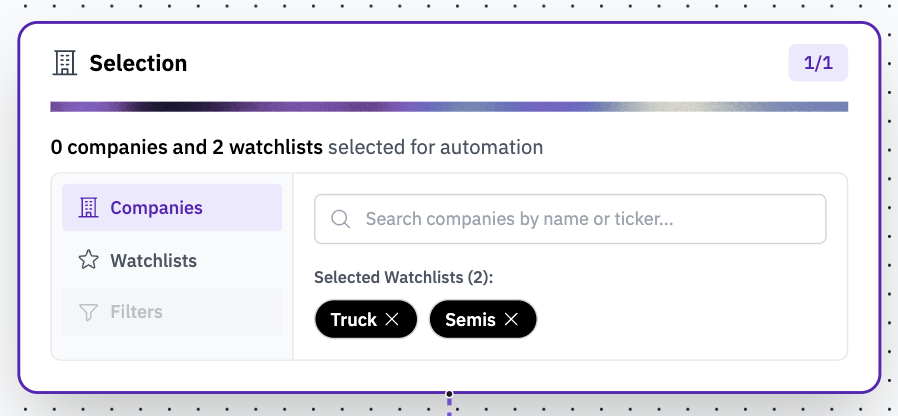
- Set a trigger
A trigger is an event that triggers the Co-Analyst to run a series of queries. The available events include:
- The time when the call transcript is finished processing
- Scheduled e.g. once every 3 months
- Based on change in price (up, down or both)
- X number of days before earnings
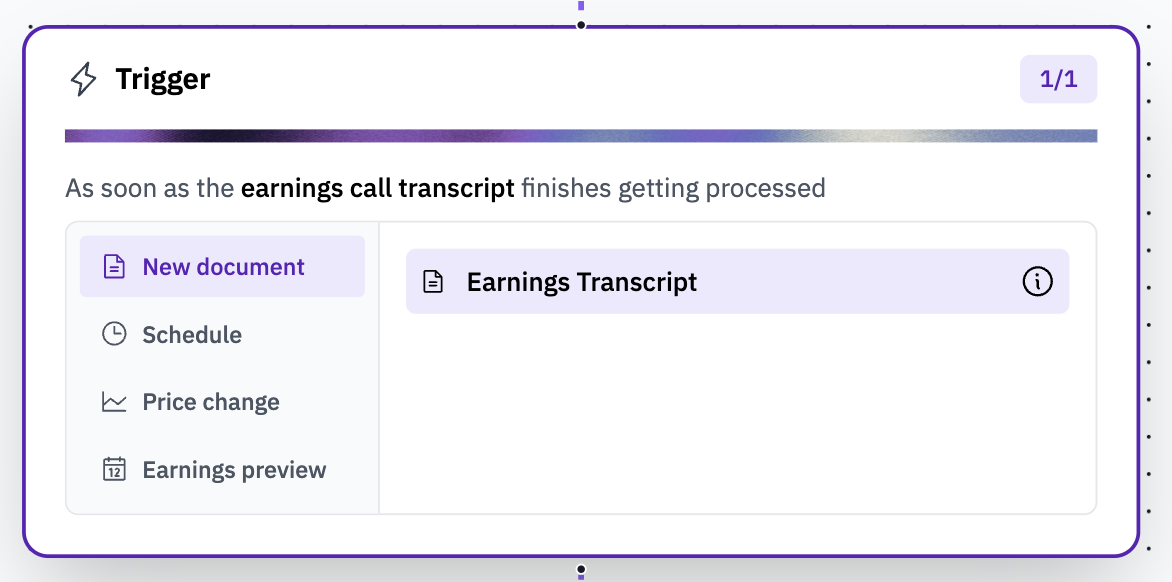
- Run a series of Co-Analyst queries
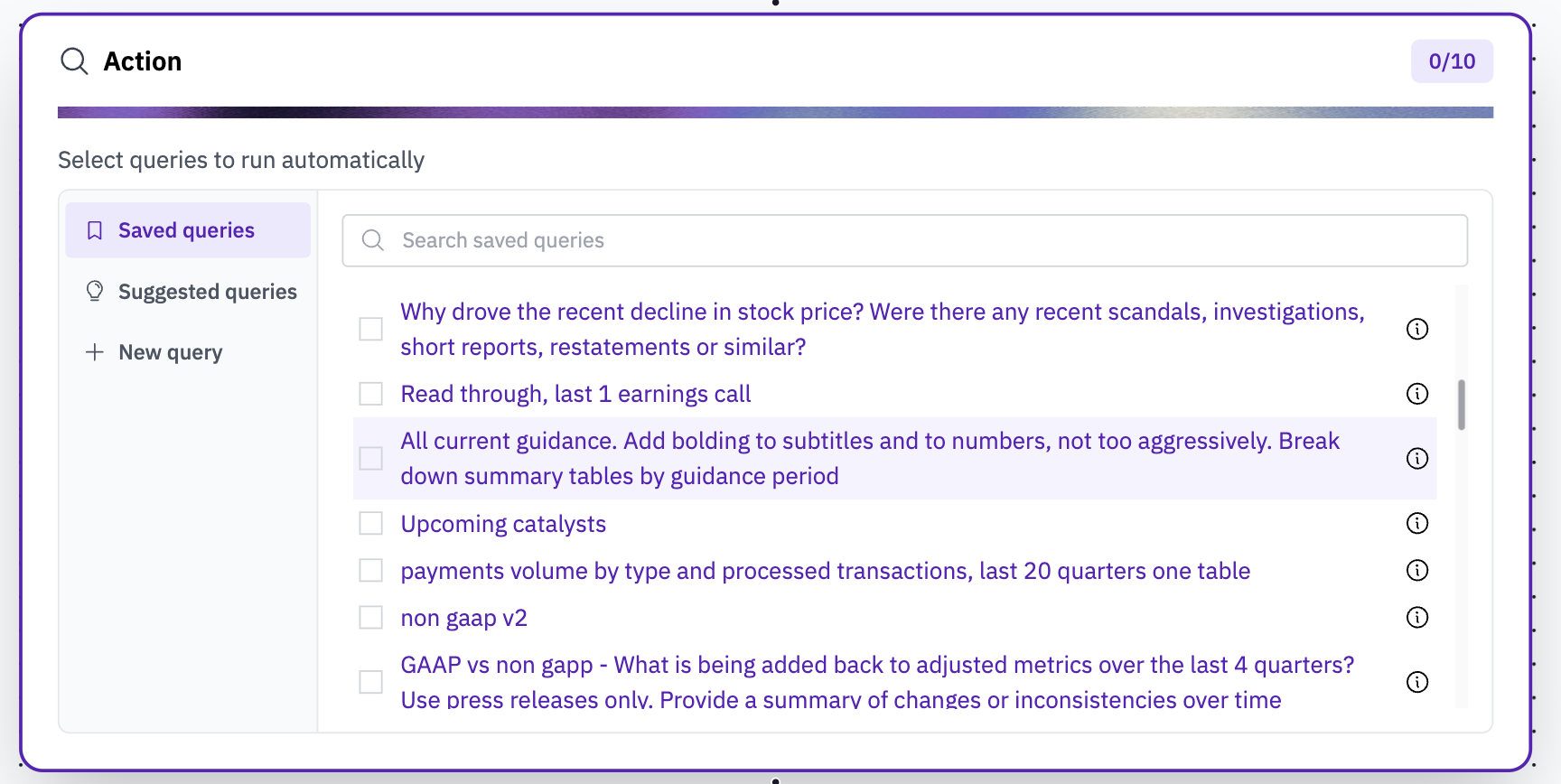
- Receive email notifications and view results in Co-Analyst Projects
Don't forget to hit save and publish!

2. The Co-Analyst
The Co-Analyst is not a chatbot. All answers are derived exclusively from source documents. We specialize in high-precision, multi-document queries. Here are a few important tips.
How to query the Co-Analyst
Use concise, straightforward language and clearly indicate the time period (e.g. most recent quarter).
Optionally, indicate the source materials to use, e.g. “from press releases only” and/or the output format e.g. “output in a single table”.
Complicated prompt engineering is not necessary and can hurt accuracy in some instances.
Queries to avoid:
- Follow up questions: Instead re-issue the complete query with additional instructions.
- Requests for information not available in sources: The Co-Analyst answers are derived exclusively from the source documents used in the query.
Source document selection for Co-Analyst query building:
The Co-Analyst answers are generated exclusively from the sources displayed on the right side of your answer. If you don’t see the answer you expect, re-issue the full query and specify which sources the Co-Analyst should use e.g. use all conference calls and 10-Qs for the last two quarters.

By default, the Co-Analyst will query either its content library (transcripts, releases, 10-Qs and 10-Ks , conference calls, presentations, and proxies) OR the web, depending on your query.
How to query the web through the Co-Analyst
To use web sources, simply add "per the web" or "use web sources" to your query.
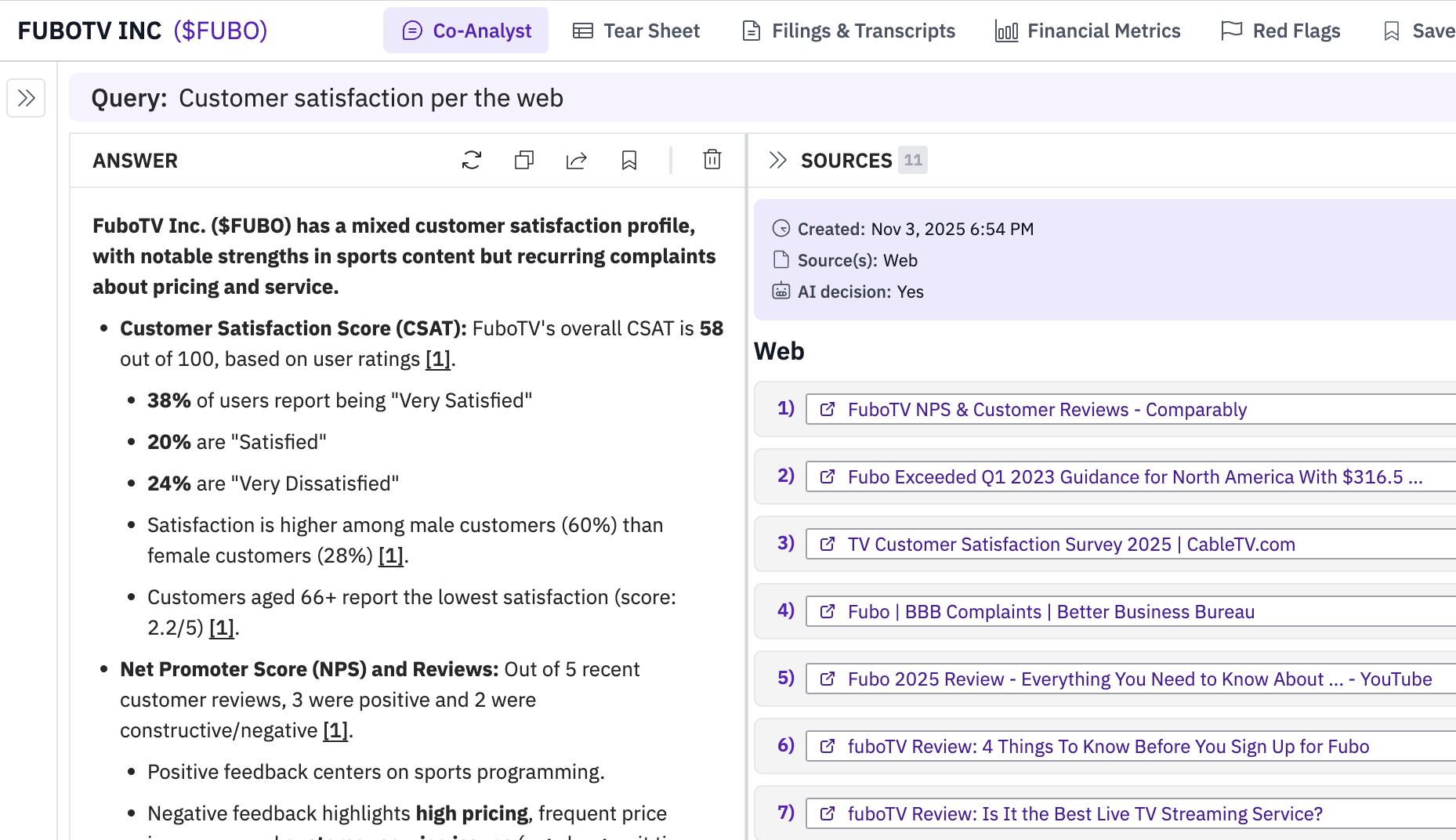
If you prefer, you can select which sources to use by using Customize.

For any document not available in the default content library, navigate to the Filings & Transcripts tab to select it directly.

Company Research Navigation
Not sure where to start? Start with a suggested query. These are most popular queries, pre-formulated for use on any company or in an automation.
Saved & Suggested Queries
Suggested queries are popular query templates designed to help you get started.
Saved queries are created by you. Save queries to reuse them later or run on other companies. Up to 5 saved or suggested queries can be run concurrently.
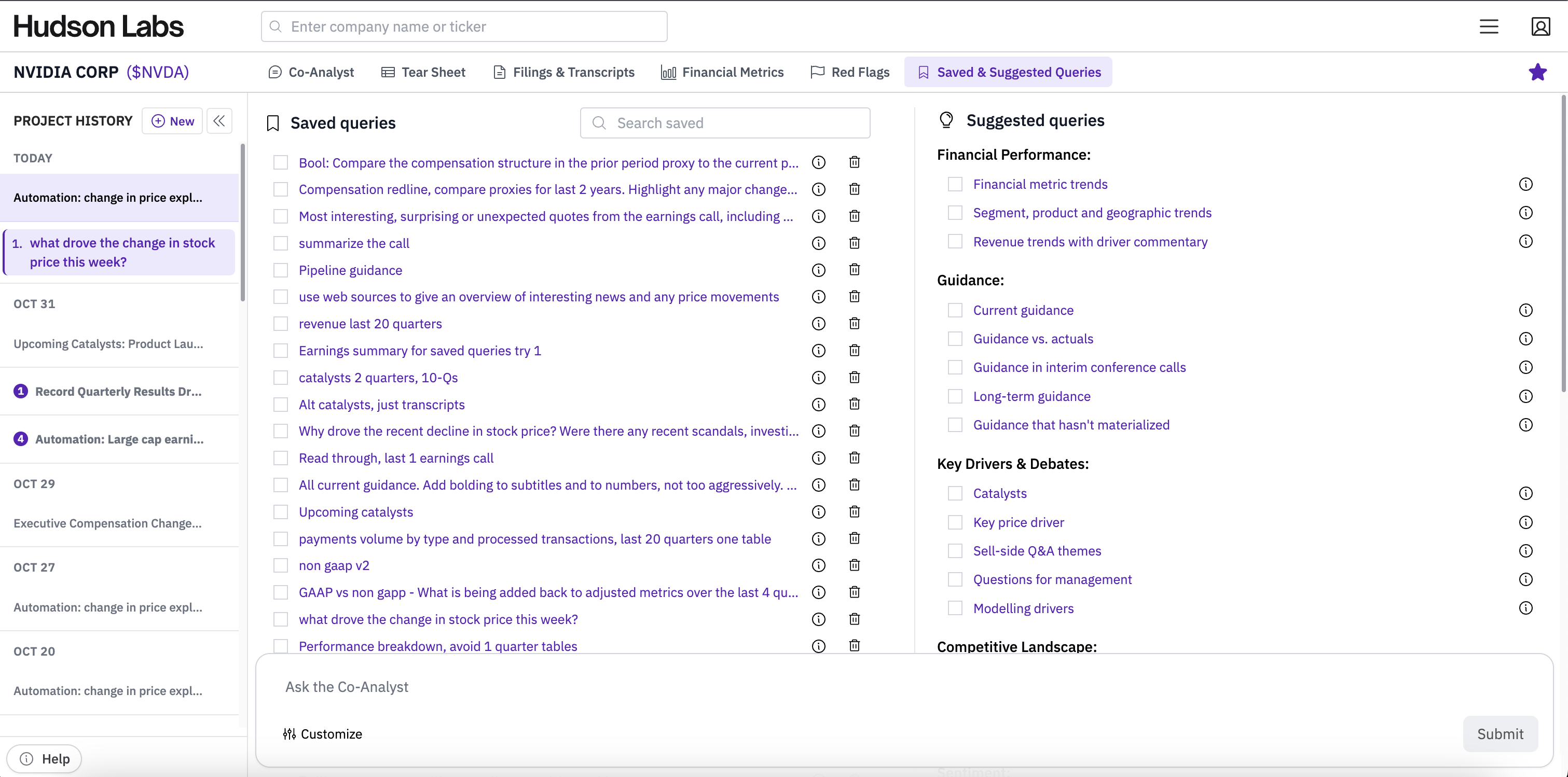
Filings & Transcripts
Find earnings and conference calls, presentations and SEC filings on this tab. Use this tab to read and query any document that is not available by default in the Co-analyst content library, e.g., proxy statements, registration statements, and prospectuses. Open the document to ask a query about that document. See more on querying individual documents.

Financial Metrics
Profitability, valuation, balance sheet, cash flow, and growth metrics, powered by S&P Global Market Intelligence. Note that the Co-Analyst does not have access to these fundamental and market metrics when generating answers.

Red Flags
Forensic risk score and red flags identified in SEC filings. Risk scores are only available to institutional tier subscribers. Find more details here.

AI citations
Select any part of the answer and click on “Cite this text” to see exactly where the information came from.


Alternatively, search for keywords or numbers in the source documents using the search bar on the right.

Query output actions - re-run, copy, share, save, delete
In the top right corner of the answer, there are several action items.

Projects
Projects are collections of queries, designed to organize your work so that you can share it with colleagues, print cohesive output and keep track of your research tasks.
.png)
Naming: The Co-Analyst will assign a name to a project if you do not. However, you can rename the projects if you prefer. In the Project History panel on the left, hover over the project and then click on the three dots that appear beside the project name. From this menu, you can rename your project.
.png)
Sharing: Click “Share” to generate a unique link that can be shared with your colleagues. Your colleague does not need a Hudson Labs account to access the answer. However, dynamic citations on this link are only available to Hudson Labs subscribers.
Export: You can also export the project into a PDF.
Deleting: You can delete individual queries in projects. You may want to do this before sharing or printing, if you ran a query multiple times to test different sources, for instance.
Access all your past projects related to the company with complete answer history in the panel on the left.
Expand the project on the left hand side to view and navigate to each of the queries:

Querying individual documents
By default, Co-Analyst queries answers queries using its default “content library” or the web. For any document not available in the default content library, navigate to the Filings & Transcripts tab to select it directly.
The Co-Analyst will source the answer exclusively from the selected document. See details of our available Filings & Transcripts here.

2. Profile and Settings
Company watchlist(s)
Manage your watchlists here or navigate to your profile and then select "Watchlists".
There is no restriction on the number of watchlists or the number of companies in a watchlist. To add or replace tickers in a watchlist, select them manually or upload a CSV or Excel file. See details of our coverage here.

.png)
.png)
Email alerts
Update your email preferences here or click on Email notifications in your profile.
Adjust the frequency of email notifications and the types of alerts. Choose to receive notifications for only the companies in your watchlists or only specific watchlists. Alternatively, receive notifications for all companies within specific sectors or market cap ranges.

Profile and Subscription settings
Change your password under Profile. Change your subscription or payment method under Subscription.

3. Forensic risk score & red flags (institutional tier)

Hudson Labs is well known for our proprietary forensic risk scores. These scores are unique because they rely entirely on non-numeric data in assessing the likelihood of fraud or malfeasance, providing a unique and significantly higher quality predictor of downside risk. Investors, insurers and accounting firms use our scores to find and avoid potential bad actors.
Hudson Labs risk scores are machine-learned, not additive. The scores are calculated using Hudson Labs’ AI-extracted red flags and reflect the interaction of these red flags/risks. Risk scores range from 1 to 100 (low risk to high risk).
Scores above 70 are considered high risk. Fewer than 10% of mid/large-cap issuers receive a Hudson Labs forensic risk score above 70. Companies with a high score have about a 1 in 3 chance of receiving an SEC enforcement action in the next three years. Scores from 60 to 70 are considered medium-high.
Risk scores are optimized for precision over recall. This means that high risk companies are very likely to experience future issues, but low risk companies may not all be in fact low risk.
Initial high risk scores tend to precede price collapse by 6 months or more. Risk scores are trained using 10+ years of SEC enforcement actions, regulatory investigations related to fraud, settled class action lawsuits and other target labels related to earnings management and malfeasance.
Hudson Labs risk scores predict fraud-related class action litigation. For example, we spotlighted Super Micro’s "hidden in plain view" risks two years before the stock freefall in 2024. See more case studies here.
Our risk analysis features cover filings since January 1, 2019 and are available for US companies only.
You can access the risk analysis features for any company under the “Red Flags” tab.
- Forensic risk score: See the full history of forensic risk scores identified for each of the annual and quarterly filings for the company.
- Most recent 10-K red flags: All red flags identified in the most recent 10-K filing by our general model. The model is trained to identify any verbiage that is associated with future probability of SEC enforcement action.
- Auditor turnover: There are a number of reasons why a public company may choose to change its accounting firm, including cost or reputation concerns. However, changes in audit firms can also be caused by tension between the management team and the team reviewing their work. These changes are therefore often considered to be a red flag. Hudson Labs provides access to auditor turnover tracking data for past 10 years, derived from the PCAOB database.
- Executive turnover: Hudson Labs uses proprietary AI modes to identify, tag and summarize turnover among executives and the board, as disclosed in 8-Ks. We track both appointments and departures (resignation, dismissal, retirement and death).
- Internal control weaknesses / Material weakness: Internal controls over financial reporting (ICOFR) are the systems and processes to make sure that the financial statements are correct. A material weakness in ICOFR means there was a failure in the company’s systems or processes that could have resulted in a misstatement in their financial statements that an investor would care about.
- Restatements: Companies disclose restatements to previous submitted financial statements in 10-Ks,10-Qs, and 8-Ks. All major restatements have Companies are obligated to disclose any major restatements of financial statements due to a material error, often called “Big R” restatements, in an 8-K.
- Non-timely filings: Non-timely forms e.g. NT 10-Ks are filed when a company is unable to meet the filing deadline set by the SEC. Non-timely forms may be an indicator of internal distress and therefore often cause or precede stock price declines
- Going concern warnings: Substantial doubt about an entity’s ability to continue as a “going concern” exists when the business faces the risk of a cash crunch or liquidity crisis in the next 12 months. This risk can be caused by insufficient revenue from operations, a large debt obligation coming due or other cash flow pressures. In short, substantial doubt about a company’s ability to continue as a going concern means there’s a real risk of bankruptcy.
- Concentrated related party risk: Hudson Labs uses proprietary AI models to identify higher-risk related party transactions and assess the concentration of related party risk across U.S. issuers. The use of language models means we can identify related party transactions, regardless of the wording or keywords and assess relative severity, facilitating advanced due diligence and market monitoring.
Our feeds are continuously updated as our AI models process new filings and call transcripts.
- Earnings calls: Find earnings calls added to the platform as soon as our models process them. We also provide the top three financial highlights from the earnings call.
- Earnings release: Each earnings release added to the feed comes with a three-point summary highlighting performance metrics and forward-looking commentary (where available).
- Forensic risk analysis feeds: We provide real-time feeds for a subset of our forensic risk features. The feeds contain a concise summary of the disclosure, focusing on the most important details.
- Material weakness
- Executive turnover
- Non-timely filings
- Restatements
- Going concern warnings
- SEC comment letters: Track SEC comment letters as they are made public. SEC’s Division of Corporate Finance (DCF or “The Division”) is responsible for reviewing securities filings. DCF staff issues a comment letter if it believes a company can better comply with a particular accounting rule or disclosure. The comment letter often contains a list of items that request additional information or disclosure, a modification to the filing or disclosure, or that the company changes how it discloses something in a future filing.
By default, our feeds are filtered to show companies with a market cap above US$300 m. Click on the Filters button on the top right of the feed to change the filters. Click on the “Watchlists” tab to only see the feed for companies in one or more of your watchlists.
5. Risk screens (institutional tier)

Use Hudson Labs’ proprietary risk screens for monitoring, idea generation and due diligence.
- Forensic risk score: Companies with a Hudson Labs forensic risk score of 60 or higher on the most recent 10-K or 10-Q. Click on the company name to see the company’s full history of risk scores for annual and quarterly filings since 2019.
- High risk score + price run-up: Companies with a Hudson Labs forensic risk score above 60 and a large recent increase in stock price. Updated daily. Click on the company name to see the company’s full history of risk scores for annual and quarterly filings since 2019.
- Concentrated related party risk: Companies with high concentrated related party risk in the most recent 10-K, as determined by Hudson Labs models. Click on the company name to see the company’s full history of related party disclosure in annual and quarterly filings since 2019.
- Last week's gainers/losers: Companies with stock price up/down from one week ago. Updated daily. click on the company name to see the company's fulll history of risk scores for annual and quarterly filings since 2019.
- Control weaknesses: Companies that disclosed a material weakness or significant deficiency in internal controls over financial reporting in the last 12 months. Click on the company name to see the company’s full history of material weakness disclosure in annual and quarterly filings since 2019.
- Restatements: Companies that reported a retrospective restatement of their financial statements in the last 12 months. Click on the company name to see the company’s full history of restatements issued by the company in 10-Ks, 10-Qs, and 8-Ks since 2019.
- Non-timely filing counts: Find companies with a high number of non-timely filings. The screen includes companies that have filed at least one NT 10-K since 2019 and are considered to be active issuers. Click on the company name to see all non-timely filings by the company since 2019.
- Going concern warnings: Companies that disclosed a substantial doubt about going concern in the last 12 months. Click on the company name to see the company’s full history of going concern warnings in annual and quarterly filings since 2019.
- Executive turnover: Find companies with a high number of resignations or dismissals of named executive officers (NEOs). The screen includes counts of turnovers since 2022. Click on the company name to see the company’s executive and board member turnovers since 2019.
- Auditor turnover: Find companies with a high
numberof auditor changes. The screen includes companies with one or more auditor changes in the past 10 years per PCAOB. Click on the company name to see all auditor changes for the company since 2014. - Smaller or foreign auditors: Companies with smaller US auditors outside the top 8 or foreign auditors. Click on the company name to see all auditor changes for the company since 2014.
By default, our risk screens are filtered to show companies with a market cap above US$300 m. Click on the Filters button on the top right of the feed to change the filters. Click on the “Watchlists” tab to only see the feed for companies in one or more of your watchlists.
Click Export on the top right to export in a CSV.








